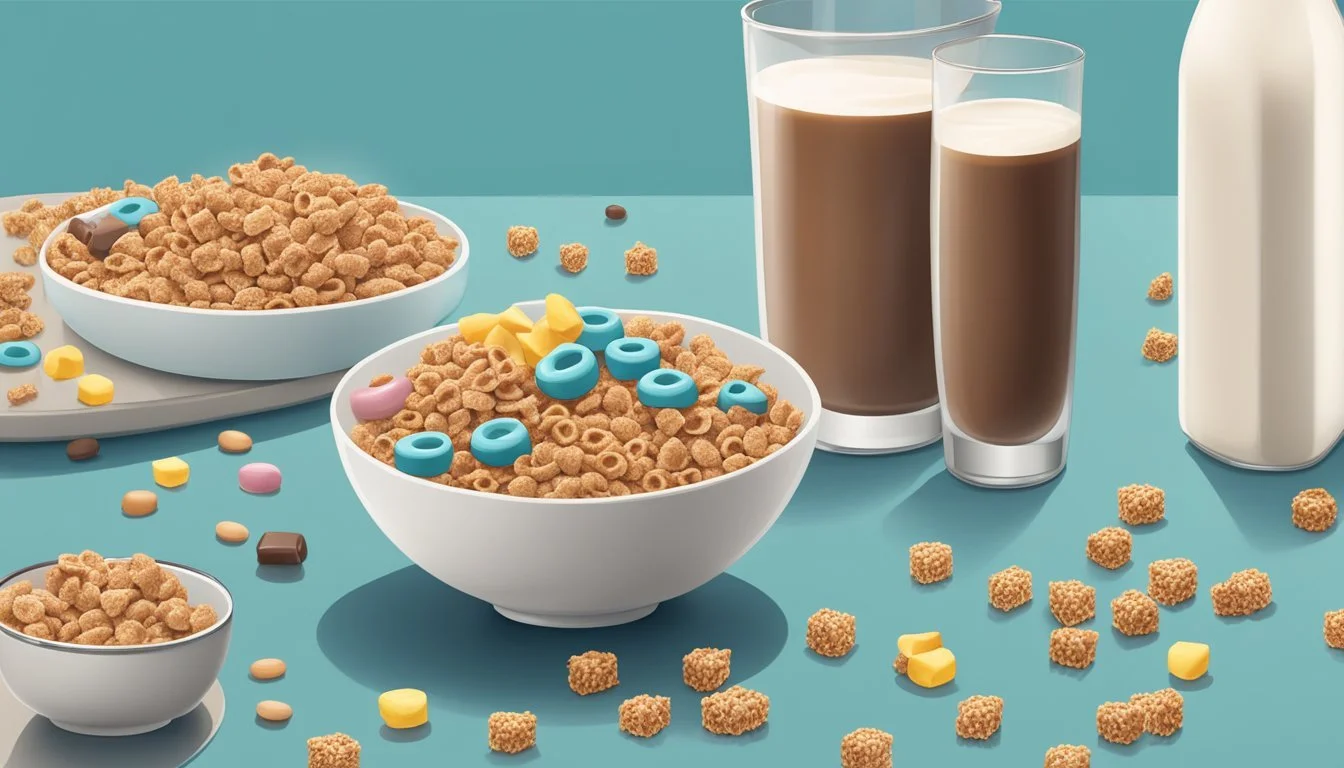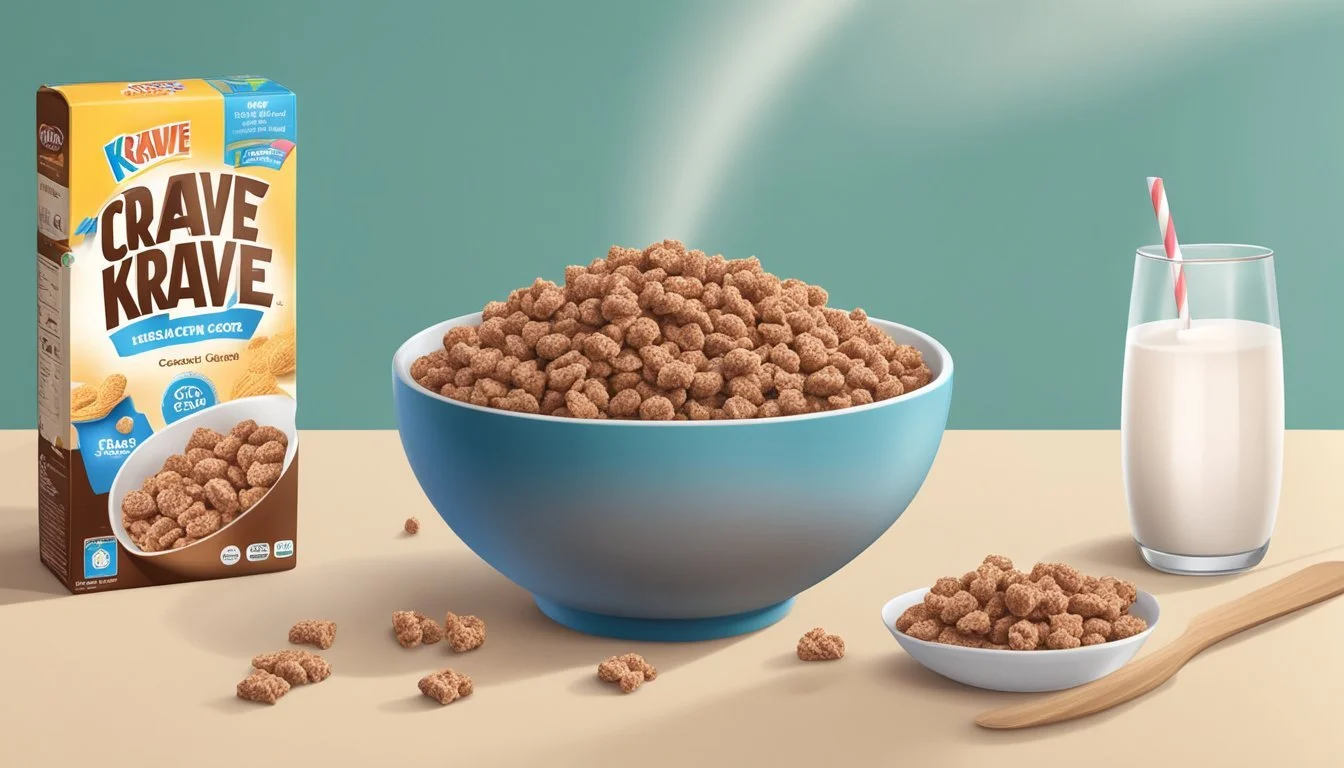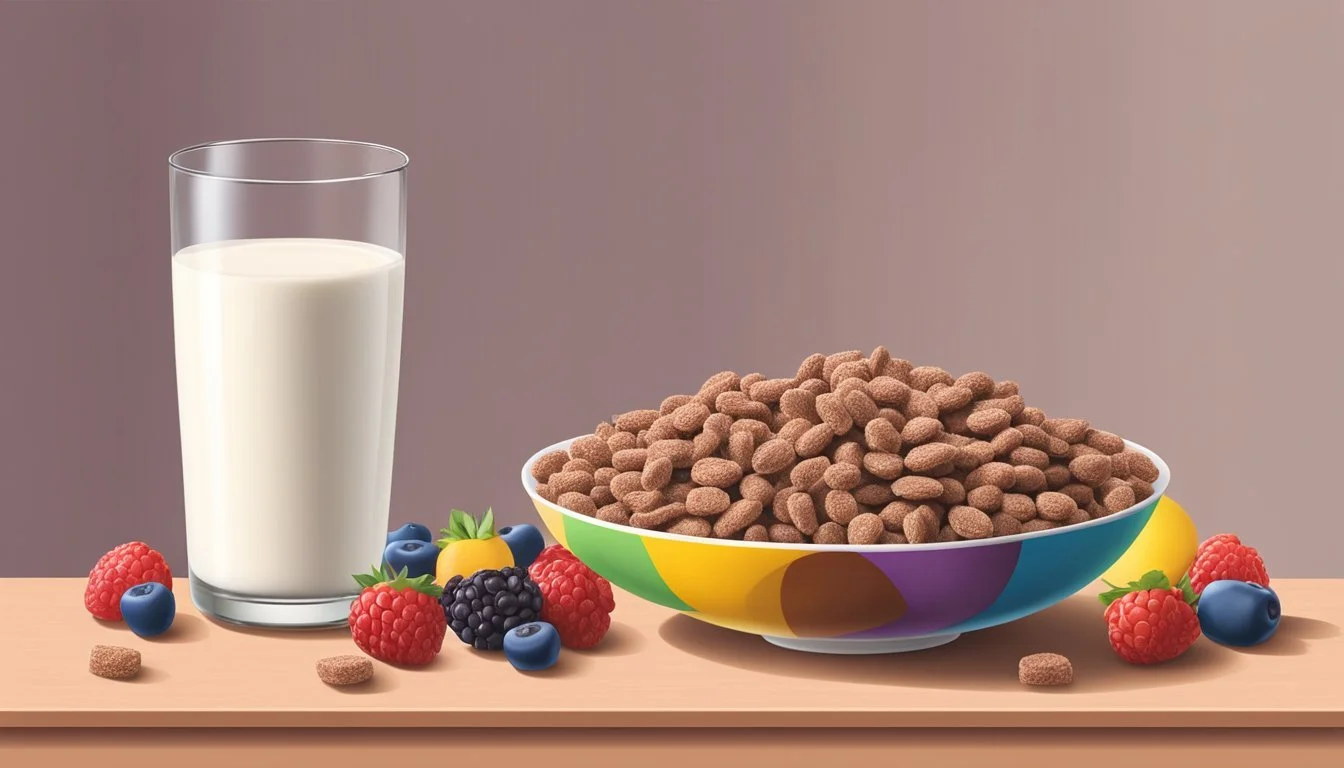Cocoa Krispies vs Krave
A Nutritional Comparison
This Article is Part of Our Breakfast Cereal Guide with Details on Cocoa Krispies Nutrition and Krave Nutrition
Introducing two popular chocolate cereals, Cocoa Krispies and Krave, both of which have amassed considerable followings among breakfast enthusiasts. Cocoa Krispies, brought to you by Kellogg's, offers a sweet, chocolatey crunch that turns your milk into a delightful chocolate treat. Krave, also from Kellogg's, takes a different approach with its filling of chocolate inside each crispy bite, creating a unique texture and flavor experience.
When comparing the nutritional aspects, it's notable that Krave contains 170 calories per serving with 15 grams of sugar. Cocoa Krispies, though similar, often attracts fans with its nostalgic snap, crackle, and pop sounds, accompanied by a sweeter taste due to its slightly higher calorie count with significant sugar content.
Choosing between Cocoa Krispies and Krave often depends on what type of chocolate experience one desires for breakfast. For those who prefer a straightforward chocolate flavor transforming their milk into a sweet beverage, Cocoa Krispies takes the lead. Conversely, Krave's filled cereal pieces offer a more textured and intricate chocolate experience, appealing to those who enjoy a burst of chocolate within each bite. Whether you favor the classic appeal of Cocoa Krispies or the modern twist of Krave, both cereals bring their delicious charm to the breakfast table.
History and Brand Overview
Cocoa Krispies and Krave are both popular chocolate cereals produced by Kellogg’s. These cereals have distinct histories and characteristics that set them apart in the breakfast cereal market.
Cocoa Krispies History
Cocoa Krispies, known as Choco Krispis or Coco Pops in different regions, were introduced by Kellogg's as a cocoa-flavored version of the already famous Rice Krispies. The cereal first hit the shelves in 1958.
Much like its unflavored counterpart, Cocoa Krispies quickly became a household staple. The cereal is known for its thin, crispy rice puffs that transform plain milk into a chocolatey delight. In Canada, this cereal is marketed as Rice Krispies Cocoa, adapting to regional preferences and maintaining its global fan base.
The product's marketing often features playful characters like Snap, Crackle, and Pop, who are integral to its brand identity and appeal, especially among children.
Krave History
Krave, also produced by Kellogg's, was introduced in the United States in 2012 but had its origins much earlier. The concept for Krave began in 1994 in Israel, where it was originally named Kariot, which translates to pillows or cushions in English.
The cereal consists of whole grain shells filled with chocolate, providing a unique texture and flavor that sets it apart from traditional chocolate cereals. Krave has been well-received due to its innovative design and rich chocolate filling.
Kellogg's leveraged its history of producing successful cereals to market Krave effectively, appealing to both kids and adults seeking a more indulgent breakfast option.
Nutritional Profile
Cocoa Krispies and Krave both provide unique nutritional values, affecting your breakfast choices.
Macronutrients and Calories
Cocoa Krispies: Each serving offers 120 calories with 1g of protein, 0.5g of fat, and 28g of carbohydrates. This includes 12g of sugar and 0.5g of fiber. The low-fat content can be beneficial for those watching their fat intake, though the sugar content is relatively high.
Krave: A serving of Krave contains 160 calories, 3g of fat (of which 1g is saturated), and 24g of carbohydrates. This includes 11g of sugar and 3g of protein. Krave has a higher calorie and fat content compared to Cocoa Krispies, likely due to the chocolate filling.
Vitamins and Minerals
Cocoa Krispies: This cereal is fortified with several vitamins and minerals. It provides significant amounts of iron and vitamin C, enhancing its role as a nutrient-dense breakfast option. However, it is relatively low in fiber and does not offer considerable amounts of calcium.
Krave: Contains iron and a trace amount of potassium, important for maintaining healthy blood levels and overall bodily function. While it is less fortified than Cocoa Krispies, Krave does provide essential nutrients in adequate amounts, which contributes to it being a reasonably healthy breakfast choice despite its higher sugar and fat content.
Flavor and Texture
Cocoa Krispies and Krave offer distinct flavor and texture experiences. These differences are vital for consumers seeking their ideal chocolate cereal.
Cocoa Krispies Flavor Profile
Cocoa Krispies deliver a rich chocolate flavor that appeals to both children and adults. The small, crispy rice pieces quickly absorb milk, transforming breakfast into a chocolatey delight with a satisfying crunch.
The cereal's sweetness is balanced, not overwhelming but just enough to make the milk turn into a chocolate milk treat. The texture is light and airy, with each spoonful providing a quick burst of flavor before it dissolves.
Krave Flavor Profile
Krave is known for its unique combination of smooth and crunchy textures. Each piece features a crispy outer shell filled with a creamy chocolate center.
The chocolate flavor is more pronounced due to the filling, offering a richer taste compared to Cocoa Krispies. The cereal is slightly sweeter, making it ideal for those with a sweet tooth. Krave's texture holds up well in milk, maintaining its crunchiness longer, providing a consistent experience from the first bite to the last.
Ingredients and Varieties
This section explores the primary ingredients and the different types of chocolate cereals available for both Cocoa Krispies and Krave, focusing on the nutritional content and options.
Primary Ingredients
Cocoa Krispies are primarily made from toasted rice, sugar, cocoa (processed with alkali), and a mix of vitamins and minerals like niacinamide, reduced iron, and folic acid. The chocolate flavor comes from the addition of real chocolate. This cereal also includes salt, malt flavoring, and artificial flavoring to enhance taste.
Krave, on the other hand, consists mainly of whole grain wheat, sugar, and cocoa processed with alkali. It is known for its unique design, with a chocolate filling inside a crunchy outer shell. Other ingredients include canola and palm oil, dextrose, and added vitamins and minerals such as niacinamide and iron. Both cereals are fortified to improve their nutritional profiles.
Chocolate Cereal Variants
Cocoa Krispies have a few notable variants including Cocoa Krispies Treats, which are ready-to-eat bars made from the cereal, and seasonal or limited editions that may feature different shapes or additional flavors.
Krave offers several variants, including Double Chocolate and Chocolate Cherry, which provide options for those looking for different flavor profiles. Additionally, Krave has introduced smaller snack-sized packs for on-the-go convenience. Different regions may also see variations in ingredient lists to cater to local tastes and dietary regulations.
Health and Diet Considerations
When comparing Cocoa Krispies and Krave, factors such as sugar content, additives, preservatives, and gluten-free options are critical to evaluate for making informed dietary choices.
Sugar Content
Sugar content is a significant factor when considering breakfast cereals. Cocoa Krispies contains about 12 grams of sugar per serving.
Krave, on the other hand, tends to have slightly more, with around 14 grams of sugar per serving. For those monitoring sugar intake, Cocoa Krispies may be a slightly better choice. Excessive sugar can lead to various health issues, including weight gain and increased risk of diabetes, so individuals seeking healthier options should consider the sugar levels carefully.
Additives and Preservatives
Additives and preservatives are common in many cereals to prolong shelf life and enhance flavor. Cocoa Krispies includes ingredients such as artificial flavors and colors. These additives can sometimes cause reactions in sensitive individuals and are often avoided by those looking for a more natural diet.
Krave also contains artificial flavors and some preservatives, but it emphasizes its filling of real chocolate, which might appeal to those preferring fewer artificial ingredients in their food. Understanding the additives and their potential health impacts is essential for those wanting a cleaner diet.
Gluten-Free Options
For individuals with gluten sensitivities or celiac disease, gluten-free options are crucial. Cocoa Krispies is not a gluten-free cereal and contains malt flavoring derived from barley, making it unsuitable for those avoiding gluten.
Krave also contains wheat and is not considered a gluten-free option. There are, however, several gluten-free chocolate cereals available on the market for those needing alternatives. It's important for consumers with dietary restrictions to carefully check labels and ingredient lists to ensure the cereal meets their health needs.
Cereal in Lifestyle
Cereal can play an important role in a balanced diet and offer convenience in the hustle and bustle of daily routines. Both Cocoa Krispies and Krave have unique characteristics that fit different lifestyle needs and preferences.
As Part of a Balanced Diet
Cereals like Cocoa Krispies and Krave can provide essential vitamins and minerals. Cocoa Krispies, for instance, are fortified with vitamins and minerals, making them a nutritious option for a quick breakfast. Their puffed rice composition combined with added nutrients can appeal to those looking to start their day on a nutritious note.
Krave, on the other hand, adds a fun twist to the morning routine with its whole-grain chocolate-filled pillows. They offer a balance of carbohydrates and fiber, alongside essential vitamins. Both cereals should be consumed as part of a balanced diet, complementing other food groups like fruits, dairy, or protein for a full nutritional profile.
Convenience and Preparation
The convenience factor is a big draw for cereals. Both Cocoa Krispies and Krave can be easily prepared by adding milk, requiring minimal time and effort, making them perfect for busy mornings. Their shelf-stable nature also means they can be stored easily for extended periods.
Rice Krispies Treats, made using Cocoa Krispies, exemplify how cereals can extend beyond breakfast into snacks. With a simple preparation process, they offer a convenient treat that fits various lifestyles. Meanwhile, Krave can serve as a ready-to-eat snack straight from the box, catering to those who need quick and easy options throughout the day.
Both cereals offer versatility and ease, fitting seamlessly into various lifestyle needs.
Consumer Preferences
When comparing Cocoa Krispies and Krave, various aspects such as taste, texture, and market trends reveal consumer preferences. Surveys and taste tests show differing opinions that make both cereals unique in their right.
Taste Test Outcomes
Taste tests are fundamental in understanding consumer preferences between Cocoa Krispies and Krave. Many prefer the crispy, chocolatey flavor of Cocoa Krispies, which boasts an immediate, rich taste.
Conversely, Krave offers a more complex flavor experience. It is lightly sweetened with a chocolate filling that builds as one eats. Cocoa Puffs and Cocoa Pebbles frequently emerge as comparative benchmarks in these tests, with Cocoa Krispies often cited for its full-bodied cocoa taste.
In taste tests, Krave has been appreciated for its layered chocolate flavor. It stands out unique, not being overly sweet compared to alternatives like Fruity Pebbles.
Texture Preferences
When it comes to texture, consumer preferences play a significant role. Many chocolate cereal enthusiasts highlight the crunchiness of Cocoa Krispies. This cereal retains its crunch in milk longer, providing an enjoyable consistency throughout the meal.
On the other hand, Krave also offers a satisfying texture experience. It combines an outer crunch with a softer interior due to its chocolate filling.
This layered texture caters to consumers seeking variety. The sogginess factor is crucial; Cocoa Krispies typically maintain their crunch better than Krave. However, those who prefer a soft bite with a crunchy exterior find Krave appealing.
Market Trends
Market trends highlight evolving consumer preferences. Cocoa Krispies have enjoyed long-standing popularity due to their familiar taste and trusted brand reputation.
Krave, relatively newer, has carved out a niche among those looking for innovative cereal experiences. Sales data often reveal seasonal spikes for both brands. Promotions and limited-time offers can significantly influence these trends.
Comparing Cocoa Pebbles and Cocoa Krispies, preferences often reflect brand loyalty and childhood nostalgia. While Cocoa Puffs and Fruity Pebbles continue to be market favorites, Krave's distinct profile is growing in recognition.
Both cereals reflect broader trends in consumer demand for both traditional and innovative breakfast options.
Environmental and Ethical Impacts
Both Cocoa Krispies and Krave have implications for the environment and ethics, particularly in terms of their packaging and the practices of the companies that produce them.
Packaging and Waste
Packaging materials for both Cocoa Krispies and Krave primarily consist of cardboard and plastic. Kellogg's, the manufacturer of both cereals, has made strides towards sustainability by pledging to use 100% reusable, recyclable, or compostable packaging by 2025. This initiative aims to reduce plastic waste significantly.
Despite these efforts, the environmental impact of plastic waste remains a concern. Recycling rates for plastic packaging are notoriously low, resulting in a substantial amount of plastic ending up in landfills. Many consumers consider this an important factor when choosing between different cereal brands.
Company Practices
Kellogg's has implemented several sustainable practices in its supply chain. They focus on reducing greenhouse gas emissions, water usage, and energy consumption. For example, they prioritize sourcing agricultural ingredients from farmers who use sustainable farming practices, which helps minimize environmental degradation.
In terms of ethics, Kellogg's commits to fair labor practices. They emphasize supporting farmers and smallholders in their supply chain to ensure equitable compensation and working conditions. However, challenges persist, and continuing scrutiny and improvements are necessary.
By integrating both environmental and ethical considerations into their operations, Kellogg's aims to set a benchmark for other companies in the cereal industry.






